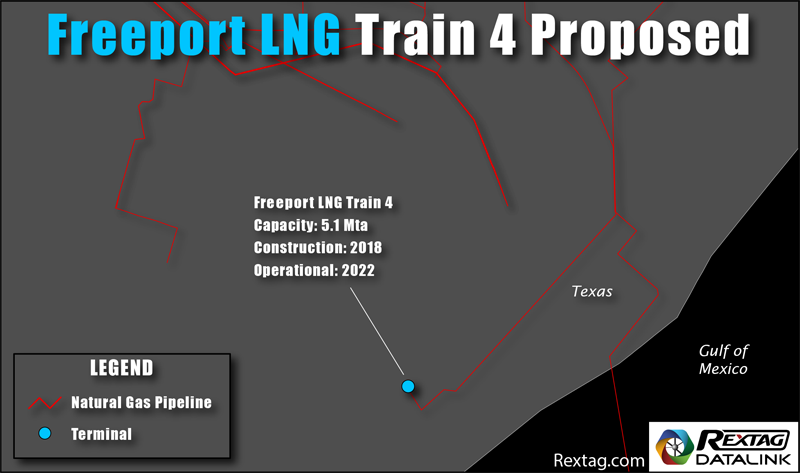Comprehensive Energy Data Intelligence
Information About Energy Companies, Their Assets, Market Deals, Industry Documents and More...
Freeport LNG Wants the Fourth Liquefaction Train
07/19/2017
Freeport LNG Files FERC Application and Commences Front-End Engineering and Design For Proposed Fourth Liquefaction Train.
The initial three Freeport liquefaction trains are currently under construction.
They are scheduled to commence operations sequentially between Q4 2018 and Q3 2019. Each liquefaction train has a capacity in excess of 5.0 mtpa.
Approximately 13.4 million tonnes per annum of the production capacity from the first three liquefaction trains has been contracted under use-or-pay liquefaction tolling agreements with Osaka Gas Co., Ltd., JERA Energy America LLC, BP Energy Company, Toshiba Corp. and SK E&S LNG, LLC.
Source: http://www.prnewswire.com
If you are looking for more information about energy companies, their assets, and energy deals, please, contact our sales office mapping@hartenergy.com, Tel. 619-349-4970 or SCHEDULE A DEMO to learn how Rextag can help you leverage energy data for your business.
Mexico Pacific LNG: A New Export Era Anchored by Permian Gas
![$data['article']['post_image_alt']](https://images2.rextag.com/public/blog/BLOG_Mexico Pacific LNG A New Export Era Anchored by Permian Gas.jpg)
Natural gas from the U.S. Permian Basin is set to be the primary source for Mexico's Pacific's Saguaro Energía LNG facility. Located in Puerto Libertad, Sonora, the Saguaro Energía LNG export facility will feature three processing trains. The site is primed for potential expansion with plans for three additional trains of similar capacity. Its strategic Pacific Coast location offers a 55% shorter shipping route to Asia, providing significant savings and reduced carbon emissions.
US Natural Gas May Update: Current Trends and Market Outlook
![$data['article']['post_image_alt']](https://images2.rextag.com/public/blog/277_Blog_US Natural Gas May Update Current Trends and Market Outlook (1).jpg)
According to the latest report from the EIA, working natural gas stocks in the United States saw a substantial increase. Stocks rose by 79 billion cubic feet (Bcf), bringing the total to 2,563 Bcf. This marks a significant year-over-year increase of 444 Bcf. Current stockpiles are considerably above the five-year average, having grown by 640 Bcf compared to the average of 1,923 Bcf.
![$data['article']['post_image_alt']](https://images2.rextag.com/public/blog/328_Blog_Why Are Oil Giants Backing Away from Green Energy Exxon Mobil, BP, Shell and more .jpg)
As world leaders gather at the COP29 climate summit, a surprising trend is emerging: some of the biggest oil companies are scaling back their renewable energy efforts. Why? The answer is simple—profits. Fossil fuels deliver higher returns than renewables, reshaping priorities across the energy industry.
![$data['article']['post_image_alt']](https://images2.rextag.com/public/blog/327_Blog_Oil Market Outlook A Year of Growth but Slower Than Before.jpg)
The global oil market is full of potential but also fraught with challenges. Demand and production are climbing to impressive levels, yet prices remain surprisingly low. What’s driving these mixed signals, and what role does the U.S. play?
![$data['article']['post_image_alt']](https://images2.rextag.com/public/blog/326_Blog_USA Estimated Annual Rail CO2 Emissions 2035.jpg)
Shell overturned a landmark court order demanding it cut emissions by nearly half. Is this a victory for Big Oil or just a delay in the climate accountability movement?